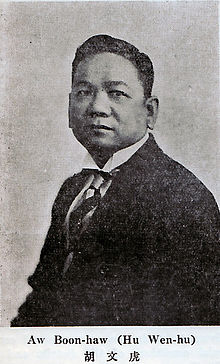Aw Boon Haw
This article includes a list of references, related reading or external links, but its sources remain unclear because it lacks inline citations. (September 2017) |
Aw Boon Haw | |||||||||||||||||||
|---|---|---|---|---|---|---|---|---|---|---|---|---|---|---|---|---|---|---|---|
胡文虎 | |||||||||||||||||||
 Aw Boon-Haw (Who's Who in China 4th ed.,1931) | |||||||||||||||||||
| Born | 1882 Rangoon, British Burma | ||||||||||||||||||
| Died | 1954 (aged 72) Honolulu, Hawaii | ||||||||||||||||||
| Resting place | Tiger Balm Garden, Hong Kong | ||||||||||||||||||
| Nationality |
| ||||||||||||||||||
| Other names | Tiger Balm King | ||||||||||||||||||
| Occupation |
| ||||||||||||||||||
| Known for |
| ||||||||||||||||||
| Board member of | Eng Aun Tong | ||||||||||||||||||
| Children |
| ||||||||||||||||||
| Parent(s) | Aw Chu Kin (Father) | ||||||||||||||||||
| Relatives | Aw Boon Leng (Eldest Brother) Aw Boon Par (Youngest Brother) | ||||||||||||||||||
Aw Boon-Haw (Chinese: 胡文虎; pinyin: Hú Wénhǔ; Pe̍h-ōe-jī: Ô͘ Bûn-hó͘; 1882 in Yangon, British Burma – 1954 in Hawaii), OBE, was a Burmese Chinese entrepreneur and philanthropist best known as founder of Tiger Balm. He was a son of Hakka herbalist Aw Chu-Kin, with his ancestral home in Yongding County, Fujian Province, China.
Career[]
In 1926, Aw migrated to present day Malaysia,[1] where he cofounded the Tiger Red Balm business with his brother, Aw Boon-Par. In the 1920s, his main factory named Eng Aun Tong(Hall of Everlasting Peace) was set up at 89 Neil Road.[2] Aw also founded several newspapers, including Sin Chew Jit Poh in Singapore and Sin Pin Jit Poh in Penang (both currently based in Malaysia); and Sing Tao Daily (which dates back to 1938 and is currently based in Hong Kong). Aw moved to Hong Kong during the Japanese occupation of Singapore[3] and managed the business from there, while his brother stayed in Singapore until he closed down the factory and went to Rangoon. One of his sons was also killed during the Japanese occupation of Singapore. Aw returned to Singapore[4] after the end of World War II and re-established his business. He set up Chung Khiaw Bank and once owned Pulau Serangoon(present day Coney Island), Singapore.[5]
Death[]
In 1954, at the age of 72, Aw died from a heart attack following a major operation in Honolulu while on a trip to Hong Kong from Boston, US. He is remembered through his work with Haw Par Villas throughout Asia, with locations in Singapore, Hong Kong, and the Fujian province of China.
Legacy[]
His sons took over his businesses after Aw's death.
Personal life[]
Aw's adopted daughter is the Hong Kong businesswoman and former Chinese People's Political Consultative Conference member Sally Aw.
The daughter of Aw Boon-Haw and his fourth wife, Aw Seng (胡星), resides in Singapore and has set up a company under her father's name, Aw Boon Haw Pte Ltd, to continue the heritage and legacy of her father.[citation needed] Aw Boon-Haw's fourth wife died on 10 April 2012 in Vancouver aged 100.[citation needed]
Gallery[]
A memorial hall in Lei Yue Mun Waterfront School
Aw Boon-Haw & Aw Boon-Par Memorial Hall at the School for the Blind, a Tiger Balm charity in Rangoon, Burma

Haw Par Villa in Fujian, unfinished after 1949 and the death of Aw Boon Haw in 1954; finished by his daughter in 1990s

Former Eng Aun Tong in Singapore

Eng Aun Tong in Guangzhou

Eng Aun Tong advertisement in 1930s
References[]
- ^ "Malaysia | Facts, Geography, History, & Points of Interest". Encyclopedia Britannica.
- ^ "Behind Our Famous Architecture". www.psd.gov.sg.
- ^ "World War Two". www.roots.gov.sg.
- ^ "Singapore | Facts, Geography, History, & Points of Interest". Encyclopedia Britannica.
- ^ "Tiger Balm king /Sam King. – National Library". www.nlb.gov.sg.
- (in Chinese) 胡文虎
- (in Chinese) 胡文虎父女的汕頭緣[permanent dead link]
- Sin Yee Theng and Nicolai Volland, "Aw Boon Haw, the Tiger from Nanyang: Social Entrepreneurship, Transregional Journalism, and Public Culture," chapter 5 in Christopher Rea and Nicolai Volland, eds. "The Business of Culture: Cultural Entrepreneurs in China and Southeast Asia" (UBC Press, 2015).
- Cochran, Sherman. Chinese Medicine Men: Consumer Culture in China and Southeast Asia. Cambridge: Harvard University Press, 2006.
- King, Sam (1992), Tiger Balm king : the life and times of Aw Boon Haw. Singapore : Times Books International, 1992. ISBN|9812043269
External links[]
- 1882 births
- 1954 deaths
- Burmese people of Chinese descent
- People from Yongding District, Longyan
- Singaporean people of Hakka descent
- Hong Kong people of Hakka descent
- 20th-century Singaporean businesspeople
- Burmese emigrants to Singapore
- Aw family
- Officers of the Order of the British Empire
- Hong Kong newspaper people
- Singaporean billionaires





